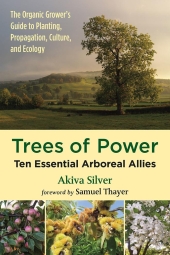





 1
1




Best luck: satisfaction
Greatest curse, greed
 3
3




It's never too late to start! I retired to homestead on the slopes of Mauna Loa, an active volcano. I relate snippets of my endeavor on my blog : www.kaufarmer.blogspot.com
 1
1














It's never too late to start! I retired to homestead on the slopes of Mauna Loa, an active volcano. I relate snippets of my endeavor on my blog : www.kaufarmer.blogspot.com








take a look at our project topic Permaculture Project Sítio Terra Abençoada in Brazil
 1
1




 1
1








 if I can ever get them before the bloody squirrels I might give it a go
if I can ever get them before the bloody squirrels I might give it a go Living in Anjou , France,
For the many not for the few
http://www.permies.com/t/80/31583/projects/Permie-Pennies-France#330873
 1
1




Best luck: satisfaction
Greatest curse, greed
 2
2




 1
1












Mick Fisch wrote:There was a discussion starting up on Staple Crops about getting oil. It was suggested that we move over to this thread to continue it. I read with interest the entry on growing and eating nuts to get all the oil a human needs. When I think about it, I have to agree that a couple of hand fulls of nuts a day would give us all we need to survive. I guess I was thinking with my belly instead of my head. My wife says that I'm digging my grave with a spoon, because I like all things fried. Probably don't need as much oil as I thought.
I remember reading in a book a few years ago that we got our word "hickory" not from the wood, tree or nut, but it was derived from a kind of nut milk that the indians would make by mashing up the nuts, boiling them up in water and then drinking the resulting milk. The author claimed they would gather bags and bags of nuts and store them. when they wanted some 'hickory' they would mash up a bunch and make it. The author said he had tried some at some gathering and that it was really tasty, although he noted concerns about the hygenic preparation from the people sharing it with him. He also mentioned that they would skim the fat of the top and use it like butter.
For those of us who haven't successfully reeducated our bellies yet, It sounds like a doable source of plant based oil.
I haven't tried to make the hickory milk yet. Has anybody else ever heard of it or tried it? Now that I think of it, I have a bag of pecans we gathered a couple of years ago in the pantry. I'll try it tonight or tomorrow and give you a report back on it.
With appropriate microbes, minerals and organic matter, there is no need for pesticides or herbicides.
 1
1




When money is the end, organisms become the tool, when organisms are the end, money becomes the tool
 1
1




David Livingston wrote:I have noticed that in permiculuture news there are details of a book recommending hazel nuts for oil production
if I can ever get them before the bloody squirrels I might give it a go
 1
1








Mick Fisch wrote:I just tried that thing i read about where they boiled the hickory nuts. My impression was that they mashed up nuts and shells and boiled it to make nut milk and get oil. I finally got around to trying it with pecans, which are a type of hickory. Almost killed my blender. I can sum up my results in one word.
NASTY!!!
I got way more shell and very little nut. I might as well have just boiled up a bunch of shells. It was undrinkable. I apologize for mentioning it prior to testing it myself.




Pamela Smith wrote:I know sunflower seeds are not perennial but they are self seeding. Birds drop seeds, when you harvest you drop seeds accidentally but one can also drop seeds on purpose when you harvest and the seeds left on the ground come up so well the next year. My friend never sows sunflower seeds. There are always lots springing up year after year.
Sunflower oil is a great source for cooking, salads etc. sunflower seeds for oil are also a great source for chickens. One can sprout sunflowers seeds for self, chickens and bovine.
 1
1








Jesus Martinez wrote:
Pamela Smith wrote:I know sunflower seeds are not perennial but they are self seeding. Birds drop seeds, when you harvest you drop seeds accidentally but one can also drop seeds on purpose when you harvest and the seeds left on the ground come up so well the next year. My friend never sows sunflower seeds. There are always lots springing up year after year.
Sunflower oil is a great source for cooking, salads etc. sunflower seeds for oil are also a great source for chickens. One can sprout sunflowers seeds for self, chickens and bovine.
One of the things that I think that people tend to overlook about conventional farming is the simplicity of harvesting it brings. If you are looking to produce oil from something like sunflowers, relying on birds to plant it for you is going to make harvesting a painful enough experience that you're likely going to plan to do it a different way. Relying on animal planting of seeds for other purposes is definitely useful, having random outcrops of sunflower is definitely useful, but if you are looking to harvest several 50gallon drums of processed seed for safe keeping over the winter, you're going to wear out your boots with all the walking.
 1
1




Thekla McDaniels wrote:What is anyone growing on perennials to press for oil? I can think of olives (but who would want to burn such precious stuff), hazel and other nuts, rosehip seeds make a nice cosmetic oil, but again, would fuel oil be a good use for that?
Still able to dream.

 1
1




Jason Hernandez wrote:
Thekla McDaniels wrote:What is anyone growing on perennials to press for oil? I can think of olives (but who would want to burn such precious stuff), hazel and other nuts, rosehip seeds make a nice cosmetic oil, but again, would fuel oil be a good use for that?
It looks like the thread lost sight of the original question, which was about fuel oil. Those Biblical oil lamps did indeed burn olive oil, but then, olives were abundant in that part of the world. It seems the quest for fuel oil is an elusive one. Would you want to burn olive oil? Avocado oil? Coconut oil? Extracting enough to be a worthwhile fuel source would seem to be more difficult on the homestead scale than the smaller quantities sufficient for food use.
In the Dominican Repermies, I have often come upon what I believe to be tung trees, although I have not been able to discover what use the local inhabitants put them to. Tung oil is toxic, used as a wood preservative, and I have not heard of its being a fuel oil, either.
Perhaps we are asking the wrong question, though. Perhaps the question should be whether it is better to grow oil crops, or raise bees for beeswax. Or maybe, instead of oil lamps or candles, alcohol lamps would be better, in which case we could distill our fuel supply.
 1
1





 4
4









Growing on my small acre in SW USA; Fruit/Nut trees w/ annuals, Chickens, lamb, pigs; rabbits and in-laws onto property soon.
Long term goal - chairmaker, luthier, and stay-at-home farm dad. Check out my music! https://www.youtube.com/@Dustyandtheroadrunners




Dustin Rhodes wrote:While also not a perennial, growing flax can give you oil, as well as fiber for Linen(although each cultivar produces more of one aspect than the other, depending on what your primary use is).
As to the production of fuel oil - I don't know which specific plant-based oil would be best, but I would be most interested if a various mix of multiple oils would be effective for this task - since we, as permaculturists, want to avoid monoculture, for the health of our land and people.
Hypothetical/Rhetorical: can a mix of walnut, olive, flax, avocado oil fuel an oil lamp? an oil heater? a diesel engine? finish wood surfaces?
Can I design my farm to grow all the species I want, in the amounts I need, for the products I tend to produce, and let the oil "byproduct" of each suit my oil needs as well?
I may live in the perfect zone to grow olives, and I may determine it to scientifically be the "best oil"(not that I do) for certain applications based on research, but if I prefer to cook with avocado oil, woodwork with walnut, finish wood surfaces with linseed oil, and can't stand the taste of olives, it is probably not the best idea to plant 100 acres of olives for all my other oil needs (I know this statement is short-sighted, and a million reasons why could be found, but this is only an example situation).




Joseph Lofthouse wrote:I am growing Clary sage as a seed oil. It is a self-seeding biennial. It's super high in Omega 3 oils.





 1
1












